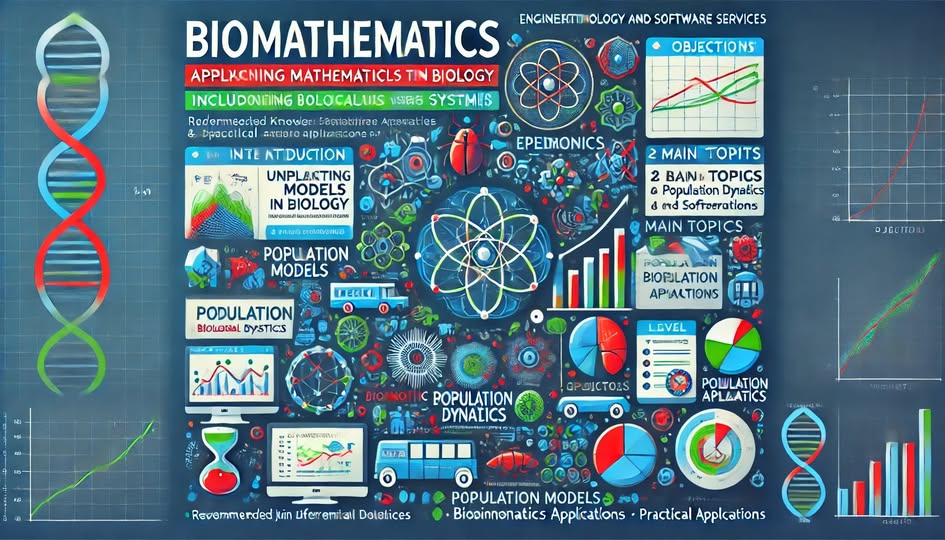
About Course
🧬 Biomathematics
Course Code: 29006-AUX
Duration: 8 Weeks | 2 Sessions per Week (Theory + Practical)
📚 Introduction:
Biomathematics is the interdisciplinary field where mathematics meets biology.
It provides the mathematical frameworks and tools needed to model, simulate, and analyze biological systems — from the spread of diseases to the dynamics of populations and genetic sequencing.
✨ Course Description:
This course explores how mathematical models are formulated and applied in biological contexts.
Students will learn about population dynamics, epidemiology, and bioinformatics, gaining a solid understanding of how mathematics drives progress in modern biology and healthcare.
🎯 Course Objectives:
-
Understand the fundamental mathematical models used in biological sciences.
-
Apply mathematical techniques to study population growth, spread of diseases, and biological data analysis.
-
Develop skills in interpreting biological phenomena through mathematical lenses.
🎯 Target Audience:
-
Advanced undergraduate and graduate students in Mathematics, Biology, Biotechnology, and Health Sciences.
-
Professionals and researchers interested in quantitative biological modeling.
-
Anyone with a background in Differential Equations and Statistics.
🛠️ Materials and Resources:
-
Software: MATLAB, Python (NumPy, SciPy, BioPython libraries).
-
Reading Material: Research papers, biomathematics textbooks, online biological datasets.
-
Tools: Simulation environments and epidemiological modeling platforms.
🧑🏫 Instruction Method:
-
1 Theory Session per week (Concepts, Models, Case Studies).
-
1 Practical Session per week (Simulations, Software Usage, Project Work).
-
Assignments and exercises based on real-world biological data.
-
Group projects and discussions on contemporary biological challenges.
🗂️ What You Will Learn:
✅ How to create and analyze population models (growth, interaction, extinction).
✅ How to model epidemics and predict disease spread (SIR models and beyond).
✅ Basics of bioinformatics, including sequence alignment and biological data analysis.
✅ Application of differential equations, probability, and statistics in biological systems.
🗺️ Detailed Course Outline:
📅 Week 1:
Introduction to Biomathematics
-
Overview of mathematical biology.
-
The role of modeling in modern biology.
📅 Week 2:
Population Dynamics I
-
Exponential and logistic growth models.
-
Mathematical description of competition and predation.
📅 Week 3:
Population Dynamics II
-
Advanced population models (age-structured, spatial models).
-
Applications in ecology and conservation.
📅 Week 4:
Introduction to Epidemiology
-
Basic concepts: infection rates, recovery rates, immunity.
-
Introduction to the SIR (Susceptible-Infected-Recovered) model.
📅 Week 5:
Advanced Epidemiological Models
-
SEIR models (adding exposed stage).
-
Vaccination strategies and modeling disease control.
📅 Week 6:
Introduction to Bioinformatics
-
Biological sequences: DNA, RNA, and proteins.
-
Sequence alignment and basic database searches.
📅 Week 7:
Data Analysis in Biomathematics
-
Statistical methods in biology.
-
Handling and interpreting biological data.
📅 Week 8:
Final Projects and Presentations
-
Develop and present a model related to population dynamics, epidemiology, or bioinformatics.
-
Real-world biological problem-solving.
🏆 Final Outcome:
By the end of this course, you will be able to:
-
Build mathematical models to describe biological systems.
-
Analyze and simulate biological processes like epidemics and population changes.
-
Use computational tools to manage and interpret biological data.
-
Integrate mathematical reasoning into biological research and applications.
Student Ratings & Reviews



